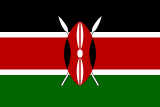Electoral system for national legislature

Kenya
Laws of Kenya, Constitution 2010 (amendments up to 2019), accessed 23 April 2022
90. Allocation of party list seats
(1) Elections for the seats in Parliament provided for under Articles 97(1)(c) and 98(1)(b), (c) and (d), and for the members of county assemblies under article 177(1)(b) and (c), shall be on the basis of proportional representation by use of party lists.
97. Membership of the National Assembly
(1) The National Assembly consists of—
(a) two hundred and ninety members, each elected by the registered voters of single member constituencies;
(b) forty-seven women, each elected by the registered voters of the counties, each county constituting a single member constituency;
(c) twelve members nominated by parliamentary political parties according to their proportion of members of the National Assembly in accordance with Article 90, to represent special interests including the youth, persons with disabilities and workers; and
(d) the Speaker, who is an ex officio member.
100. Promotion of representation of marginalised groups
Parliament shall enact legislation to promote the representation in Parliament of—
(a) women;
(b) persons with disabilities;
(c) youth;
(d) ethnic and other minorities; and
(e) marginalised communities.
In total the National Assembly shall consist of 350 members elected in the following way: a) 290 members directly elected in single-member districts using FPTP; b) 47 women members representing each county as single-member constituencies also directly elected using FPTP system; c) 12 members are appointed using party lists, allocation in this case is based on the number of directly won seats in the FPTP system described above (the purpose of this allocation is to give under-represented groups a voice in the political system, see Article 100 of the Constitution). In addition to above, there will be a Speaker, who is an ex officio member.